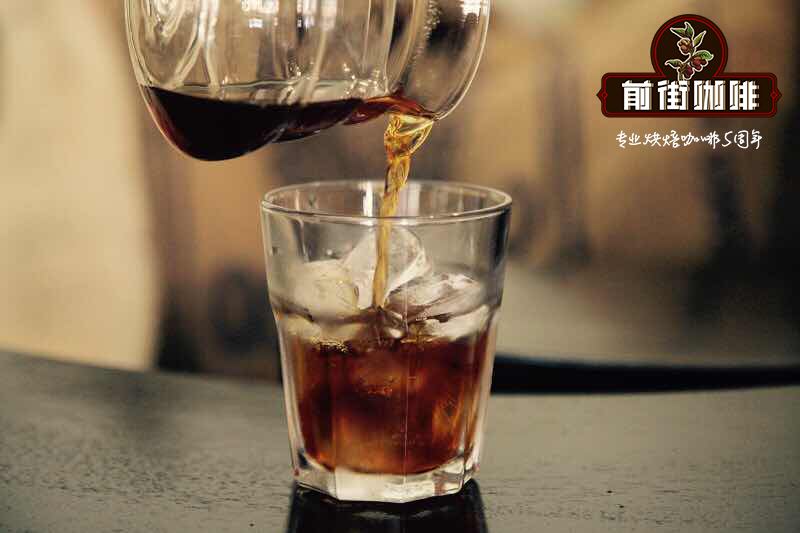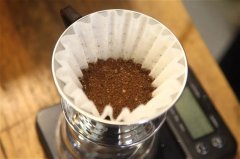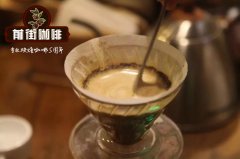Hand brewing coffee competition players brewing skills how to brew coffee champion how to make coffee?

Professional coffee knowledge exchange More coffee bean information Please pay attention to coffee workshop (Weixin Official Accounts cafe_style)
The World Coffee Brewing Competition requires contestants to demonstrate both exceptional brewing skills and service. In front of three judges, contestants from around the world prepare and brew three drinks. In the preliminary round, competitors complete one of the designated brewing events and one of the free brewing events. In the designated brewing event, the contestant needs to prepare the drink with the coffee beans specified and provided by the competition. In the free brewing event, contestants can choose their own coffee beans and brewing method, and must demonstrate the brewing process in front of three judges.
1st place: Norway contestant Odd-Steinar Tollefsen's brewing method
Norway contestant Tollefsen uses green coffee beans from 90+ Ethiopian Sunkissed and describes his roasted coffee beans as "further improvements to the honey kiss." This green coffee bean is shade dried. While noting that only seven packets of green beans were roasted, Tollefsen said,"You only know how good it tastes when it dances in your mouth, because coffee speaks for itself." If you make a lot of comments before you drink it, it's pretty irresponsible."
Tollefsen used 20 grams of powder and 300 grams of 92-degree water in a Hario V 60 filter cup for hand-brewed coffee. Steaming time is 45 seconds, total extraction time is 3 minutes 30 seconds. Tollefsen uses natural mineral water from the west coast of Norway, which is softer and smoother with lower minerals.
To allow judges to have real-time brewing data, Tollefsen uses Bluetooth to connect the Acaia electronic smart coffee scale to an Apple phone. Tollefsen's hand brewed coffee smells of tropical fruits, apricots, mangoes and passion fruits; tastes of strawberries in addition to the fruits described above; sweet and persistent, accompanied by high quality acidity with passion fruit and mango flavors. Tollefsen finished the game exactly under 10 minutes.
Second place: Greek Konstantinos Latridis 'brewing method
Konstantinos Latridis of Greece uses a microbatch of coffee beans from Panama. Latridis chose a Hario V 60 filter cup and brewed it using 15 grams of powder and 250 grams of water. First, Latridis steams in 96-degree water for 30 seconds, then uses the rest of the water to finish brewing.
Latridis explained to the judges that he chose the V60 filter cup just like he chose filter paper because it was easy to control the hand brew with the V60 and filter paper would make the coffee taste clean. Latridis also emphasises that the coffee has slight berry, chocolate and stone fruit flavours; smells of magnolia, black honey and white tea. With floral and juicy flavors, this coffee is described by Latridis as "tasting like washed sun beans." The Latridis race lasted 9 minutes and 32 seconds.
Third place: Swiss player Benjamin Prager's brewing method
"Kenya is, to me, the best country in the world to grow coffee beans," began Benjamin Prager of Switzerland, describing Kenya's sweet, clean, and intense flavor. Prager said: "In Kenya, coffee's natural growth zone is the closest to perfection." The beans he chose grow on the south side of Mount Kenya, at an altitude of 1800 meters, near Nigeria. Because coffee beans grow in soils that contain volcanic ash nutrients, Prager said,"the rich taste of coffee reflects the abundance of soil nutrients."
For Prager's brewing technique, his choice of filter cup is Hario V60, which uses 14 grams of sifted coffee powder, first using a 350 micron stainless steel filter, then a 250 micron stainless steel filter. A total of 236 grams of water was then used, of which 30 grams was used for steaming. Prager's method is a one-shot injection that drops at a constant temperature with the water temperature, rather than a staged injection, because he thinks it helps increase the creamy feel of the coffee.
Coffee harvests in December and is stored in multi-layer plastic bags designed for grain storage after being harvested, sunburned or washed. Prager notes that the coffee smells of floral, red currant and blackcurrant; it tastes moderately light and has blueberry tea, blue grape and blackcurrant flavors. Prager finished the game exactly under 10 minutes.
Fourth place: American contestant Sarah Anderson's brewing method
For this cooking competition, Anderson, the fourth-ranked American, used [the species eugenioides from Colombia,] from Colombia, which Anderson himself called "the breeder of arabica beans." Because of its intense sweetness and delicate acidity,"this coffee tastes quite different," Anderson says. The crop was about 200 pounds last year, but it's going to grow. Grown in a greenhouse, the beans are "somewhat delicate and require people to adjust their surroundings to suit their growth," Anderson said, adding that the beans are then placed in stainless steel fermentation vessels. Anderson and her Intelligentsia team in Los Angeles conducted more than 80 roasting tests, and even more from Copenhagen's Coffee Collective, to choose the best roasting method.
Anderson uses an Alto Air brewing device (pictured above), which cooks 19 grams of flour and 300 grams of water in 8 minutes and 30 seconds. Anderson chose to steam in a glass for 1 minute and 30 seconds before pouring into a nest filter cup filled with filter paper. This method of brewing will impress the judges. Anderson told the judges: "One of my favorite experiences is bringing something new to my customers. But you are professionals in this field, and you are tasting the best coffee, how can I give you an unprecedented experience?"
Anderson's coffee smells of brown butter, black tea, and balanced, bright cream; tastes of sugar cane sweetness, barley tea charred, melon softness, and ripe peach acidity.
Fifth place: Dutch player Kerkhoff's brewing method
Rob Kerhoff's opening line is brilliant: "Welcome to the mini coffee station. Every aspect of coffee is full of innovation." Innovation will also be reflected in his brewing process. Kerhoff uses coffee beans from El Diamante, Costa Rica, using anaerobic fermentation. Whether it's the kadua variety or the kadura variety, coffee beans smell cinnamon after 20 hours of fermentation.
Kerkhoff invented his own brewing method. Kerhoff said,"I wonder what kind of coffee I like. I like the body of coffee when I drink it and the brightness of coffee made by Chemex." He combined the two methods, placing Chemex filter paper in the strainer of the French press. Kerhoff used 18 grams of powder and 300 grams of water, 120bp, 7.1 ph, 93 degrees. The extraction time was 5 minutes and 30 seconds, stirring was continued to optimize the extraction yield. Kerhoff's final coffee has a slight malate, a sweet, fresh cinnamon flavor and a medium to light taste. Kerhoff finished the race in 9:40.
Sixth place: Russian player Ruslan Shulga's brewing method
Ruslan Shulga from Russia uses green coffee beans from Emerald Manor grown at an altitude of more than 1700 meters. Shulga says "sunbaked beans are quite sensitive to temperature during baking." In fact, Shulga tried more than 20 baking experiments with different bean dryers before finally deciding on the baking method to use for the competition.
Shulga uses 15 grams of powder and 250 grams of water and is hand brewed in a V60 filter cup. The coffee is rich in fruit acids. Shulga's coffee smells of citrus, caramel, and vanilla; tastes of peach iced tea, citrus, caramel, and with a moderately sweet citrus acid. As coffee temperature decreases, acidity becomes more pronounced.
WBrC, English full name for the World Brewers Cup, Chinese translation of the World Handbrewed Coffee Competition The World Craft Coffee Competition is part of the WCE One of the seven international events of World Coffee Events is the American Fine Coffee Association (SCAA) and the European Fine Coffee Association (SCAE), which are behind the scenes to promote fine coffee all over the world. It is also one of the fashion sports events that are popular with young people all over the world and increasingly concerned. The WBrC champion is a joint representative of WCE, SCAA and SCAE.
With the rapid development of coffee industry in China and the rise of culture, the international market will pay more attention to "China", which is an important stage to promote fine coffee to the world, and is also one of the fashion competitions that are popular with young people all over the world and are increasingly concerned.
Important Notice :
前街咖啡 FrontStreet Coffee has moved to new addredd:
FrontStreet Coffee Address: 315,Donghua East Road,GuangZhou
Tel:020 38364473
- Prev

The flow rate of coffee is abnormal. Why? What are the factors affecting the flow rate of coffee?
When I'm usually making coffee, I feel anxious watching the speed of the coffee liquid flowing down. But I don't know where to start. I think the degree of grinding is too fine. Is it a little thicker or is there no way to save your cup of coffee? Don't worry. Today, the editor will talk to you about what factors will affect the flow rate of a cup of coffee. | | filter cup |
- Next

How to choose the filter paper for hand-brewed coffee? what are the good ones to buy? what are the recommendations?
Professional coffee knowledge exchange more coffee bean information please pay attention to the coffee workshop (Wechat official account cafe_style) different hand-made coffee filter cups, will affect the taste of coffee? Uncle Coffee: we have previously introduced three kinds of hand-brewed coffee filter cups: trapezoidal, conical and wave filter cups, all of which may affect the taste of coffee. The biggest key is the flow rate of water.
Related
- Beginners will see the "Coffee pull flower" guide!
- What is the difference between ice blog purified milk and ordinary milk coffee?
- Why is the Philippines the largest producer of crops in Liberia?
- For coffee extraction, should the fine powder be retained?
- How does extracted espresso fill pressed powder? How much strength does it take to press the powder?
- How to make jasmine cold extract coffee? Is the jasmine + latte good?
- Will this little toy really make the coffee taste better? How does Lily Drip affect coffee extraction?
- Will the action of slapping the filter cup also affect coffee extraction?
- What's the difference between powder-to-water ratio and powder-to-liquid ratio?
- What is the Ethiopian local species? What does it have to do with Heirloom native species?

